This file is copyrighted. It will be used in a way that qualifies as fair use under US copyright law.
| Core races | |||
| Allied races | |||
Template:Racebox
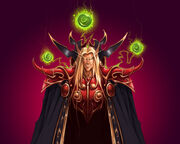
Prince Kael'Thas Sunstrider, Lord of Quel'Thalas
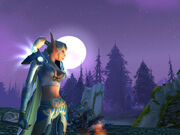
- For playable blood elves, see blood elf (playable).
The blood elves, or sin'dorei ("Children of the Blood" in Thalassian), are a race composed of former high elves who renamed themselves in honor of their people that were killed during the siege of Quel'Thalas by the Scourge during the Third War. The blood elves of Azeroth have joined the Horde in the Burning Crusade expansion, seeking to reunite with Prince Kael'thas Sunstrider in Outland. They have since reclaimed their capital of Silvermoon City, situated in Eversong Woods. Lor'themar Theron led them in Kael'thas's absence. Now having discovered Kael'thas's true objective to summon Kil'jaeden to the world, the blood elves have abandoned the Prince of the blood elves for their own needs. No leader has officially been made, but Lor'themar Theron along with Halduron Brightwing and Grand Magister Rommath have kept the blood elf race in check and continue to do so as of Patch 2.4.0.
Introduction
Blood elves once called themselves high elves. In the transition that led to this renaming, they glorified their civilization while discarding their honor. Life for the blood elves changed during the Third War, when King Arthas’s Scourge sacked Quel’Thalas and shattered the elven race. The Scourge slew more than 90% of the high elven population, devastating their culture. Prince Kael’thas Sunstrider was studying magic in Dalaran at the time of the disaster. When he heard what had happened, he quickly returned home and took command of the survivors. Kael’thas renamed them “blood elves” in honor of their fallen kin. Prior to the Sunwell’s destruction, all high elves everywhere were constantly bathed in its magical power. Now bereft of this arcane energy, the blood elves (and high elves) suffered. Kael’thas claimed that they would soon die without another magical source to replace the Sunwell. The blood elves therefore set about learning to drain magic from alternative sources.
Soon, the blood elves clashed with the Scourge and the Amani trolls, who were making inroads into former elven territory. The blood elves defended their homeland, and eventually, having reestablished a degree of safety to their land and prevented their society from degenerating, Kael’thas left. He took a group of the strongest blood elf warriors and spellcasters and joined the Alliance against the Scourge. They were eager to avenge themselves on the undead forces. However, bigotry prevented the human forces from seeing the aid the blood elves could bring to their fight. Imprisoned and sentenced to death by the humans who had commanded them, the blood elves escaped, fled to Outland, and joined Illidan Stormrage’s forces. This group of blood elves then helped defeat the demon Magtheridon and claimed his Black Citadel as their own.
In exchange for the blood elves’ loyal service, Illidan gave them a place to live, as well as further techniques to siphon mana from anything with arcane power. Blood elves on Outland now hunt demons and feed off the demons’ magic. As a consequence, despite what other races might suspect, blood elves are hardly on friendly terms with demons. Indeed, blood elves too view demons with abhorrence. Even blood elf warlocks believe demons are useful tools, not potential allies. Not every blood elf lives in Outland. Most blood elves still live on Azeroth, particularly in Quel’Thalas. These blood elves seek to reclaim their lost homeland and destroy the Scourge at any cost.Template:Cite A lone representative, Rommath, was sent back to Azeroth with a message of hope for the blood elves remaining in Quel'Thalas: that one day Kael'thas would return to lead his people to paradise. Rommath has made great progress in teaching the blood elves advanced techniques to manipulate arcane energies. With renewed purpose, the blood elves have now rebuilt the city of Silvermoon, though it is powered by volatile magics. Emboldened by the promise of Kael'thas' return, the weary citizens of Quel'Thalas now focus on regaining their strength, even as they forge a new path into an uncertain future.Template:Cite While they despise most other races, they have come to accept that the Forsaken are different, or at least share the same goals as the blood elves. The blood elves in Outland do not give the Alliance or the Horde much thought. They are busy seeking power and honing their abilities.Template:Cite
History
Ten thousand years ago, during the reign of the night elf Queen Azshara, there was an elite magic-using sect known as the Highborne, who dabbled in magics that many other elves considered heretical by drawing upon the power of the Well of Eternity. Fiercely loyal to the Queen, the Highborne opened a number of portals under her direction that brought forth the Burning Legion, triggering the War of the Ancients. Some time after the Great Sundering, most of the surviving Highborne were exiled from Kalimdor and settled on the Eastern Continent, founding the kingdom of Quel'Thalas. They became known as high elves. During this time, they created the Sunwell, and switched to a diurnal waking cycle. Their purple skin eventually faded to a pale peach color, like that of some humans and dwarves.
For the history of the high elves in the years between their exile and the Third War, see High elf.
During the Third War, Prince Arthas led his army of the Scourge against them, ravaging Quel'Thalas and corrupting the Sunwell. Most of what was left of Quel'thalas was burned down by the high elves, in an effort to give the Scourge a psychological victory and leaving the few high elves left who were making their last stand on Sunstrider Isle. Despite their efforts, most of the high elven population were eradicated during this conflict. In remembrance of their fallen brethren, most of them renamed themselves the blood elves, or sin'dorei, and swore to avenge their fallen race.
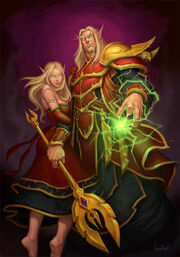
Cut off from their source of power once again, the elves went into magic withdrawal. Desperate for aid following the Third War, the blood elves allied with the naga. This was seen as treachery by the Alliance and they were sentenced to death. Prince Kael'thas Sunstrider led his followers to freedom, to the extra dimensional wastes of Outland, the remnants of Draenor, and pledged allegiance to Illidan who promised to grant them a new source of magic by siphoning the chaotic energies of demons. Together with their allies the naga, Illidan led the blood elves to conquer Outland, gaining in the process the friendship of the nearly extinct Broken. The blood elves then followed Illidan to the Icecrown Glacier in an attempt to destroy the Lich King. However, they were defeated by Arthas, who wounded Illidan, forcing the blood elves and naga to retreat, allowing Arthas to ascend the glacier and merge with the Lich King.
But not all blood elves currently reside in Outland with Illidan: some have remained in Azeroth. Flushed with their newfound ability to siphon mana from creatures of the Twisting Nether, the blood elves have managed to retake their beloved land of Quel'Thalas. Silvermoon has been rebuilt and the resident blood elves there plot to return to Outland, where they can reunite with Kael'thas and achieve the golden destiny he promised them.
Unfortunately, the decisions of Kael'thas to continually accept the aid of the naga and willingness to use fel magic has caused blood elves to be shunned by the Alliance. Thus, the remaining blood elves on Azeroth looked to the Horde to help them reach Outland. Addiction to fel magics and the desperate search for a cure are things the orcs are very familiar with, and many older orcs who've experienced similar addictions feel a kinship with the blood elves. The trolls who have been the ancient enemy of all quel'dorei since antiquity accepted them warily.
The Forsaken have been working closely with the blood elves to purge the greater Plaguelands of Scourge presence since their induction. Lor'themar Theron was Sylvanas Windrunner's second in command during the Second Battle of Quel'Thalas, and many Forsaken were high elves culled from the same battle. The aid provided by the Forsaken has included reinforcements, a number of outposts in and around the reclaimed blood elf territories, and a teleportation device between the Undercity and Silvermoon.
The Sunwell Restored
It appears that after the encounter involving Kil'jaeden, that the Sunwell powers were exhausted (thanks to Anveena sacrificing herself) in banishing Kil'jaedan back to the Twisting Nether. However Velen and Lady Liadrin appear shortly after his banishment, Velen then proceeds to dropping M'uru's small flickering "spark" into the Sunwell, with that a huge pillar of light emerges from the Sunwell, with which Velen responds in saying:
"In time, the light and hope within- will rebirth more than this mere fount of power... Mayhap, they will rebirth the soul of a nation."
This article or section includes speculation, observations or opinions possibly supported by lore or by Blizzard officials. It should not be taken as representing official lore.
|
This strongly indicates that the Sunwell has indeed been restored using M'uru's energies. Although M'uru's remains were weak, in time it will regenerate to full strength and return for the blood elves their "fount of power". This shows that indeed the blood elves haven been fully 'redeemed' so to speak, their addiction at this point in time one could argue has been eliminated since their fount of power has been restored, though it's very likely that the blood elves addiction has only been dampened for the time being. The consequences one could foresee would be immense, since their arrogant nature and quick temper was caused by the Sunwell's destruction, with this restored, their whole culture could undergo another transformation. Also seeing as how the Sunwell was infused with the remains of a being of Light, it remains to be seen if the well will radiate the energy and essence of Light, instead of arcane power as it once did. If the first guess is true, then while the blood elves will get the soothing properties described of light, their addiction for arcane magic probably won't go away with a snap of a finger.
Physical appearance
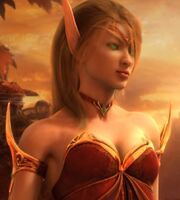
A CGI representation of a blood elf priest
Blood elves between the Third War and World of Warcraft were physically identical to high elves, save that they dressed primarily in blacks and reds to remind themselves of their terrible losses. Many painted runes or mysterious tattoos on their faces, arms and shoulders for warding off demons or celebrating significant kills or simply to look intimidating — something high elves would never do. As well, they adopted hair styles that went against the norms of high elf society.Template:Cite Nevertheless when approaching Alliance towns blood elves would often disguise themselves as high elves to avoid harm. Template:Cite The sin'dorei likely have life spans similar to high elves (see life spans). How fast they age is unknown but is likely similar to that of the high elves.
Blood elves also have slim athletic bodies, long pointy ears, acute senses and keen sight in the darkness. Night elves have long, slanted ears while blood elves' ears are shorter and tend to point upwards. See High elf for a more complete description.
While it was once believed that blood elves and high elves were exactly the same biological race,[1] separated more by cultural differences than physiological ones, it has since been determined that they are, in fact, beginning to evolve into a separate race, due largely to their consumption of mana from primarily fel sources Template:CiteTemplate:Cite. This reliance on fel magic causes the eyes of blood elves to glow green with demonic fire.Template:Cite This readily available source of energy also tends to give blood elves a ruddier or paler look compared to their quel'dorei cousins. A blood elf can appear like a high elf bearing odd red tattoos across her face and arms. However, his hair and skin is much paler than that of a high elf, and his eyes glint with a green light, and he wears blood-red robes.Template:Cite These represent signs of evolution from their high elven cousins, and it is believed that, with time, they may become as physically distant to high elves as satyrs are to night elves Template:Cite (see Wretched, and Felblood elves).
Recently, those blood elves which were most loyal to Kael'thas Sunstrider have been gifted by Kil'jaeden with the privilege of engorging themselves on copious amounts of demonic blood, seemingly hastening their demonic evolution into what have come to be known as felblood elves, developing a variety of demonic traits in the process. Those blood elves and high elves who succumb to their magical addition and descend into madness are counted among the Wretched.
In The Frozen Throne, blood elven eyes were depicted white and pupil-less, both in-game and in official artwork.
Culture
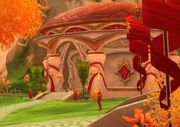
Blood elven architecture
Blood elves wear crimson-colored robes to suggest their fiery affiliation and the blood of the fallen elves in Quel'thalas. Many concentrate on studying arcane and fire magic, as opposed to the traditional frost and water spells of their lost high elf society.
Blood elf architecture is much like high elf architecture (Allerian Stronghold as an example of high elf architecture in-game) it involves pendulous creations of wondrous curves and columns, its designs natural, floral, flowing, animal. Their fountains seem to defy physical boundaries, creating or warping water in impossible ways. Blood elves have flags that feature a phoenix. In the Third War, Blood Mages had the ability to call phoenixes from the Elemental Plane of fire. These creatures appear to be deeply connected with the blood elves, possibly because they share a destructive nature, or perhaps due to their purely magical composition. This could allow the blood elves to have increased control over them. Since the phoenix dies and becomes reborn, it could be a symbol for the blood elves -- the blood elves metaphorically 'died' as high elves and were reborn as blood elves.
Blood elves speak Thalassian and Common. Blood elves learn the languages of their allies.Template:CiteTemplate:Cite In World of Warcraft players speak Thalassian and Orcish.
Magical addiction
Since the destruction of the Sunwell at the hands of Arthas and the Scourge, the blood elves have been forced to deal with the sudden relapse of their addiction to arcane energy. A constant curse since the original Well of Eternity was destroyed, the addiction has become more powerful than ever. Blood elves spend their waking days struggling with their weakness, seeking either to sate it by siphoning magical energy from their surroundings or to resist the urge to feed.
Blood elves are addicted to the use of arcane magic. A blood elf must spend one hour each morning in meditation, resisting the distractions of their addiction. Blood elves have learned to slake their thirst through the absorption of fel energies. If the blood elf partakes of demon’s blood, the magic addiction abates for a number of days.Template:Cite
While the blood elves do not abstain from draining arcane power directly, they are careful to keep their addictions under control, keeping the power their new abilities offer while maintaining self-discipline. Those who lose control over their addiction change into "The Wretched," and invariably fall into insanity and corruption.
As Arcanist Helion (a starting zone quest NPC) says, "Control your thirst for magic...It is a thirst unending."[2]
Classes
Many blood elves are warlocks or mages, though some become hunters, scouts, or warriors — especially those seeking to be spell breakers, demon hunters, and rangers.Template:Cite A few continue to draw power from the Light and remain priests. Some blood elves take their demonic obsession one step further and become felswornTemplate:Cite, and others choose to draw on the magic of the Legion and become Blood Mages.
Alignment
Most blood elves are not insane or evil—they just choose to fight fire with fire. They were suffering for lack of the Sunwell; they all needed—and still need—to feed on arcane energies, even though most of them aren't spellcasters. The most powerful blood elf spellcasters are insane, as the magic they wield is corrupting.Template:Cite On the other hand, the Farstriders, using little magic, are considered to be the epitome of selfless dedication, and are called valiant, honorable and noble on the official site.[3] In fact it is said the Farstriders are one of the few blood elf groups that still has some honor and nobility associated with it.Template:Cite
Relationships
While they hate most races, they have come to accept the Forsaken, as they share the same goals.Template:Cite The western Horde recognizes the blood elves as dangerous, volatile and ultimately destructive.Template:Cite The Horde orcs, Darkspear trolls and tauren distrust the blood elves, as their addiction to magic makes the high elves look like amateurs. The blood elves are dangerous, and the Horde races can smell the rotten magic on them. In particular, the orcs revile the blood elves because they see them as descending down the same path toward damnation that so corrupted the orcish people — the orcs can smell the demon taint on the blood elves and know how badly it will twist them. The blood elves disdain the Horde as barbarians who refuse to grasp power in front of them. They especially dislike the orcs, who should have been strong enough to control the power the demons gave them instead of falling under their command.Template:Cite Blood elves reek of fel power, offending the spiritual senses of night elves and tauren.Template:Cite
Varanis Bitterstar fighting the undead Scourge
Blood elves feel betrayed by the Alliance and are enemies of both humanity and the night elves. The blood elves try to draw the remaining high elves into their fold — a concept the goodly high elves view with horror and revulsion. Indeed, the existence of the blood elves demonstrates the depth of the corruption possible for this once mighty race, and the high elves see them as a dire warning. Many high elves seek to make amends for evils wrought by their demented kin. Blood elves get along well with the naga — with whom they share Highborne ancestry — and other independent factions. They are not welcome in Alliance lands.Template:Cite The Alliance represents all that the blood elves hate in the world. The humans led the exodus from Lordaeron, abandoning the blood elves to the Scourge, taking many high elves with them. The high elves are weak; they have potential to reach blood elf status, but they will not embrace the power and therefore are of little use. The night elves are remembered as the elves who banished them from their homes so very long ago, and those grudges still run deep. The other races are disliked merely for their representation in the Alliance — the friend of my enemy is my enemy, so to speak. The Alliance view them as dangerous (and mad, in some cases). The arcane spellcasters in the Alliance agree that the blood elves have gone too far in their quest for power — even the high elves are sickened and frightened by their former allies’ loss of compassion and self-control. The blood elves have little use for the Alliance, and the downfall of this faction is next on their list after they have purged the Scourge from Lordaeron.Template:Cite
The blood elves consider the naga their allies and friends. The other neutral races that interest them are the goblins, dark trolls and forest trolls. The goblins are the only merchants who will sell to the blood elves without prejudice; if an Alliance or Horde merchant would even allow a blood elf to look at her goods, she would most certainly raise the prices astronomically. The troll tribes often have items or information of use to the blood elves, and they hate the night elves with almost the same passion. The blood elves have few opinions on the other independent races — those that worship a divine power are weaklings, and those that remain neutral are of little consequence. Template:Cite
Many blood elves have insinuated their way back into the world and seek out places rich in magical power — such as Ashenvale Forest. Some blood elves, steeped so thick in pain and anger, have joined the Shadow Council in Felwood.Template:Cite
Notable blood elves
 Archmage Aethas Sunreaver - Archmage of the Kirin Tor. Current Blood Elven member of The Six.
Archmage Aethas Sunreaver - Archmage of the Kirin Tor. Current Blood Elven member of The Six. Prince Kael'thas Sunstrider - Last scion of the Sunstrider dynasty. Official ruler of the blood elves.
Prince Kael'thas Sunstrider - Last scion of the Sunstrider dynasty. Official ruler of the blood elves. Regent Lord Lor'themar Theron - Ruler of the blood elves on Azeroth in Kael'thas' absence.
Regent Lord Lor'themar Theron - Ruler of the blood elves on Azeroth in Kael'thas' absence. Ranger-General Halduron Brightwing - Blood elves' military commander on Azeroth and leader of the Farstriders.
Ranger-General Halduron Brightwing - Blood elves' military commander on Azeroth and leader of the Farstriders. Grand Magister Rommath - Leader of all blood elf magi on Azeroth. Herald and fiercely loyal servant of Kael'thas.
Grand Magister Rommath - Leader of all blood elf magi on Azeroth. Herald and fiercely loyal servant of Kael'thas. Magister Astalor Bloodsworn - Magister in charge of M'uru. Responsible for manipulation of M'uru's energies for the Blood Knights.
Magister Astalor Bloodsworn - Magister in charge of M'uru. Responsible for manipulation of M'uru's energies for the Blood Knights. Lady Liadrin - Matriarch and first of the Blood Knights.
Lady Liadrin - Matriarch and first of the Blood Knights. Pathaleon the Calculator - Agent of Prince Kael'thas.
Pathaleon the Calculator - Agent of Prince Kael'thas. Voren'thal the Seer - The leader of the Scryers in Outland.
Voren'thal the Seer - The leader of the Scryers in Outland. Ambassador Sunsorrow - The blood elf Ambassador to the Forsaken.
Ambassador Sunsorrow - The blood elf Ambassador to the Forsaken.
Speculation
This article or section includes speculation, observations or opinions possibly supported by lore or by Blizzard officials. It should not be taken as representing official lore.
|
Appearance
Blood elf physical traits are likely to be passed down genetically, though it is also possible that some traits may also be passed down from mothers to children while they are in the womb, or even by breast feeding. Given that most of these traits are the result of exposure to fel energy and not withdrawal (the surviving high elves do not suffer any withdrawal symptoms other than a slightly more haggard appearance), they are likely permanent, as with the color of orcish skin.
Alignment
In the December 2005 issue of Computer Gaming World for The Burning Crusade Metzen had once said blood elves are not an evil race.[4]
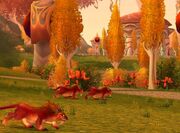
The blood elf starting area, Sunstrider Isle
Tensions from the aftermath of the Second War have become burning hatreds. The high elves officially withdrew from the Alliance after the Second War under the belief that not enough troops were sent to protect Quel'thalas, and thus led to a needlessly engorged amount of slaughter and destruction. A few high elves remained under their own volition to continue serving the Alliance, but the loyalty of even these voluntary troops waned after the second sacking of Quel'Thalas by Arthas, to which the Alliance took no steps in intervening. Finally, with Lord Garithos's dismissive, blatantly racist treatment of high elven troops and attempt to execute many blood elves for accepting boats from naga, even more fell under the sway of Kael'thas' new vision for his people, and the high elves who remained loyal even after all of the Alliance's poor policies in dealing with the elven race still faced discrimination from the very people they served in Theramore and Stormwind.[citation needed]
As a result, blood elves are fierce jingoists, believing that the only people they can truly trust are their own. They are perceived as reckless and haughty, exhibiting none of the serenity or calm judgment of their ancestral peoples, and jumping at opportunity and quick solutions with little regard for the consequences. They believe power is not something to be earned -- it is to be taken. Power is something to be manipulated for yourself and the greater good of all blood elves. This reasoning also plays into how the blood elves successfully drained pure Light energy from the naaru to become Blood Knights, and paying no interest to the Paladin credos of benevolence or balance with the universe (although regular paladins can unknowingly be corrupt).[citation needed]
The official The Burning Crusade webpage mentions blood elves having a "dark destiny".[5] This likely refers to the fact that blood elves under Kael'thas had joined with the Burning Legion, under the demonic Illidan and the naga. This likely is not in reference to the majority of blood elves who were left on Azeroth that do not know about Kael'thas' decision. Indeed, many of those back on Azeroth chose to turn against Kael'thas when they learned of it.Template:Cite A large faction of blood elves previously under the direct command of Kael'thas defected, and are now known as the Scryers, and currently operate to fight against the prince.
Could blood elves rejoin the high elves?
With the recent developments of the banishment of Kil'jaeden and the restoration of the Sunwell, one could argue that the blood elves have in effect been restored to high elves or could return to being high elves. The elves no longer have to turn to fel magic to feed their addiction, and it has been speculated that the Sunwell's energies can reverse the physical changes that come with fel consumption (although there is not yet any evidence to support this), hinting at the possibility of reconciliation.
At this point, however, there are many cultural differences between the high elves and the blood elves, and there are probably only a handful of blood elves who would even choose to revert. On the flip side, most high elves regard the blood elves as traitors, and would not take them back.
See also
- Blood elves (playable)
- Rise of the Blood Elves, from the History of Warcraft
- History of the blood elves
- List of blood elves in Azeroth
- Blood elf units in Warcraft III
- Blood elf controversy
References
External links
 World of Warcraft Community Site The Warcraft Encyclopedia - Blood Elves
World of Warcraft Community Site The Warcraft Encyclopedia - Blood Elves World of Warcraft Community Site Official Burning Crusade Flash Site
World of Warcraft Community Site Official Burning Crusade Flash Site
| ||||||||||||||||||||||||
Template:Lang
